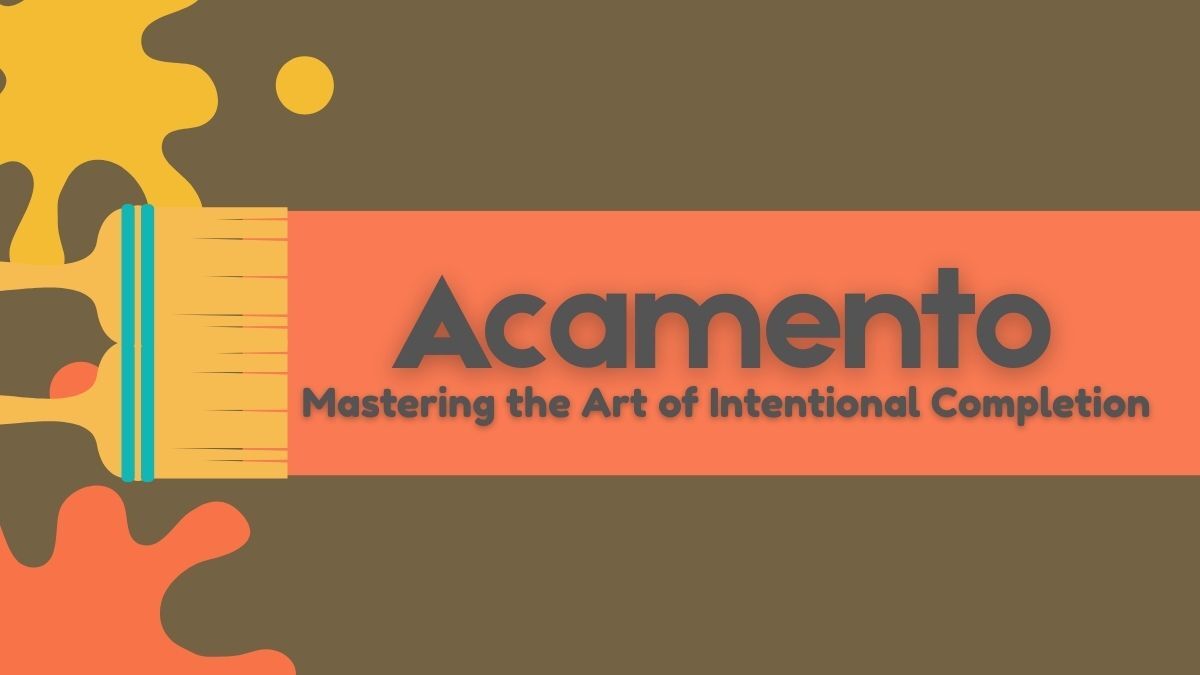GENERAL
Acamento: Mastering the Art of Intentional Completion

Acamento is the intentional and refined act of completing a task with precision, purpose, and high quality. Rooted in the Portuguese word acabamento, meaning “finishing” or “final touch,” it emphasizes thoughtful enhancement rather than mere completion. Whether applied in design, craftsmanship, projects, or personal endeavors, Intentional completion elevates outcomes by focusing on detail, intentionality, and excellence. This philosophy transforms ordinary work into extraordinary results, highlighting the value of refinement and mindful completion in every aspect of life.
Understanding Acamento: Definition and Essence
It is not merely the act of finishing; it is a philosophy. Rooted in Portuguese craftsmanship traditions, it emphasizes meticulous attention to the concluding stages of any process. While many approaches focus on functionality or rapid completion, Intentional completion prioritizes refinement, aesthetic coherence, and enduring quality.
- Precision: Ensuring every element aligns correctly and functions seamlessly.
- Purpose: Making deliberate choices that enhance both form and function.
- High Quality: Elevating the outcome to a standard that demonstrates mastery and care.
This principle can be applied universally, from architecture and fashion to digital design and personal productivity.
Historical and Cultural Roots of Acamento
The concept of acamento is deeply rooted in Portuguese culture, where artistry and craftsmanship have long been celebrated. In traditional Portuguese architecture, for instance, intricate tilework and finely carved woodwork showcase Intentional completion in every detail. Similarly, in Portuguese textiles and furniture, the finishing touches, polishing, stitching, and trimming, reflect an unwavering commitment to excellence. Beyond Portugal, the philosophy resonates with global movements in design and craftsmanship that emphasize quality over speed.
Acamento in Design and Craftsmanship
1. Architecture
Architectural projects often require attention to subtle details: the alignment of tiles, the smoothness of plaster, and the consistency of paint finishes.
2. Furniture and Product Design
In furniture and product design, Intentional completion is expressed through meticulous joinery, seamless edges, and perfectly applied finishes. Consumers may not consciously notice these refinements, but they significantly impact durability, usability, and overall satisfaction.
3. Digital Design
Even in digital contexts, acamento plays a critical role. User interfaces, websites, and applications benefit from thoughtful design choices such as consistent typography, intuitive navigation, and polished transitions. Attention to these final details enhances user experience, fosters trust, and signals professional excellence.

The Benefits of Acamento
- Elevated Quality: Refined finishing elevates the perceived and actual quality of work.
- Professional Credibility: Demonstrating care and precision builds trust with clients, peers, and audiences.
- Enhanced Aesthetics and Function: Thoughtful completion optimizes both appearance and usability.
- Personal Satisfaction: Completing work intentionally and with high standards fosters a sense of accomplishment.
- Long-Term Value: Well-finished projects are durable, timeless, and more impactful.
Acamento in Professional and Personal Projects
The philosophy of Intentional completion extends beyond traditional craftsmanship into professional and personal projects. Completing work with deliberate care fosters both credibility and lasting impact.
1. Professional Work
In corporate and creative fields, acamento can transform standard outputs into extraordinary results. For example, a report with precise formatting, clear visuals, and polished language demonstrates professionalism and attention to detail. Similarly, marketing campaigns that undergo careful refinement, ensuring messaging, visuals, and timing align perfectly, achieve greater effectiveness.
2. Personal Projects and Daily Life
It is equally relevant in personal endeavors. From organizing a home space to preparing a presentation, the thoughtful enhancement of final steps increases satisfaction, clarity, and aesthetic appeal. This mindset encourages individuals to approach tasks not only with competence but with artistry and intention.
Principles of Acamento
- Attention to Detail: Every component matters. Small refinements often define the overall quality of the result.
- Consistency: Cohesion and uniformity in execution convey professionalism and enhance perception.
- Functionality and Aesthetics: Acamento balances practical utility with visual or experiential appeal.
- Deliberate Enhancement: Every touch should have a purpose, avoid superfluous additions while amplifying impact.
- Reflection and Evaluation: Assessing work from multiple perspectives ensures that final touches truly elevate the outcome.
Applying Acamento in Everyday Life
While Intentional completion often associates with high-level design or craftsmanship, its principles can enhance everyday life:
- Organization: Completing tasks with careful attention ensures efficiency and clarity.
- Communication: Crafting messages, emails, and presentations with refinement improves understanding and impact.
- Self-Development: Applying acamento to personal goals, like skill-building or habit formation, reinforces intentionality and mastery.
Cultivating the Practice of Acamento
- Prioritize Final Touches: Allocate dedicated time for refinement and review.
- Develop Critical Eye: Train yourself to notice inconsistencies, gaps, and opportunities for improvement.
- Seek Feedback: Constructive critique helps identify overlooked details and enhance overall quality.
- Embrace Continuous Improvement: Adopt an iterative approach, refining outputs until they reach their highest potential.
FAQs
Q1: What is the difference between acamento and ordinary task completion?
While ordinary completion focuses on finishing a task, Intentional completion emphasizes precision, purpose, and high-quality refinement, turning ordinary results into exceptional outcomes.
Q2: Where can acamento be applied?
It can be applied in design, architecture, product creation, digital interfaces, professional projects, personal goals, and everyday life tasks.
Q3: How does acamento benefit professionals?
Professionals practicing Intentional completion produce polished, credible work that enhances reputation, trust, and long-term impact.
Conclusion
Acamento transcends the simple act of finishing; it is the intentional, refined practice of elevating outcomes through precision, purpose, and high-quality enhancement. Rooted in Portuguese tradition yet universally applicable, it enriches design, craftsmanship, professional projects, and personal endeavors alike. In a world that often values speed over quality, Intentional completion reminds us that true mastery lies in the details, the deliberate touches that transform the ordinary into the extraordinary.
-

 BIOGRAPHY7 months ago
BIOGRAPHY7 months agoBehind the Scenes with Sandra Orlow: An Exclusive Interview
-

 HOME1 year ago
HOME1 year agoDiscovering Insights: A Deep Dive into the //vital-mag.net blog
-

 HOME1 year ago
HOME1 year agoSifangds in Action: Real-Life Applications and Success Stories
-

 BIOGRAPHY1 year ago
BIOGRAPHY1 year agoThe Woman Behind the Comedian: Meet Andrew Santino Wife




























